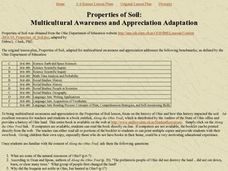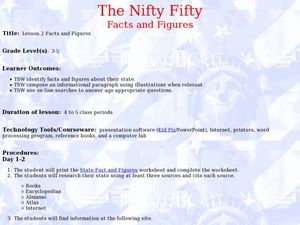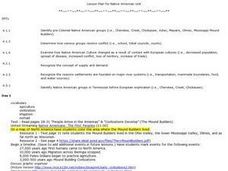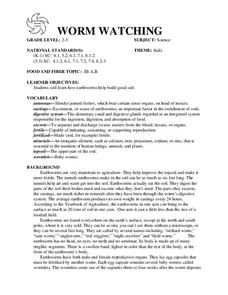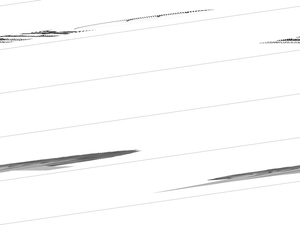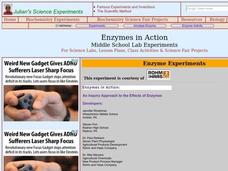National Endowment for the Humanities
“Read All About It”: Primary Source Reading in “Chronicling America”
Can investigative journalism become too sensationalistic and accusatory, or is it vital for the survival of a democracy? Middle schoolers analyze primary source documents from early 20th-century newspapers as well as Theodore...
Curated OER
Properties of Soil
Students encounter various pieces of knowledge utilizing lessons that addresses a diversity of learners with multiple intelligences. They cover various concepts: science, Earth, scientific inquiry, geometry, data analysis, probability,...
Curated OER
Genetically Modified Foods in Perspective
Students research the concept of genetically modified foods. The purpose of the research is to increase science content knowledge and comprehension of the controversy surrounding the subject.
Curated OER
Unit: Processing and Manufacturing: Examination Three
StudentsMatch the vocabulary terms in column A with the definitions in column B. Write the letter of the definition in column B in the space next to the terms in column A. Afterwhcich, students Write short answers or fill in the blank to...
Curated OER
Does The Lab Coat Fit?
Students describe the steps in the research process and identify the three requirements for a true experiment. They define independent and dependent variables. They discuss the Agriscience Student of the Year award and list the five...
Curated OER
DNA: The Human Body Recipe
Students describe DNA and the roles in which engineers are involved with the human body. For this DNA lesson students participate in a class demonstration.
Curated OER
The Nifty Fifty- Facts and Figures
Young scholars explore an assigned state. In this United States geography lesson, students identify facts and figures related to a particular state. Young scholars use the Internet for research and create a PowerPoint presentation...
Curated OER
Mulch
Students conduct a series of experiments on mulching. In this earth science lesson, students discuss the benefits of mulching on soil. They explore how different types of mulch affect plant growth.
Curated OER
Human Evolution
Students recognize that achievements of human beings throughout human history can be considered part of the ongoing story of human evolution. They research settings such as the biosphere and Mars and write imaginative short stories using...
Curated OER
Pre-Colonial Native American Groups
Students investigate U.S. history by researching the Internet and taking a test. In this American Indian group lesson, students identify the many specific Native American tribes and their geographic locations. Students research the web...
Curated OER
Contrasting Landscapes - UBC Farm Field Trip
Learners visit the UBC Farm. In this lesson on various landscapes, students spend a day at the University of British Columbia exploring the farm and trail adjoining the campus. This lesson could be modified for use in any region that has...
Curated OER
WORM WATCHING
Students investigate how earthworms help build good soil. They examine the worms carefully to find the ringlike segments and swollen band at the front of the earthworm's body. Students take turns dampening the soil every day and adding...
Curated OER
Biomass: The Energy of the Future
Sixth graders examine information about a variety of renewable fuels. They read key vocabulary terms, read and discuss a story handout, and conduct research on renewable fuels. Students then complete a comparison chart, and write an...
Curated OER
Oklahoma Wheat on the World Market
Sixth graders explore profit and loss in the wheat trading market. In this sixth grade mathematics lesson/social studies lesson, 6th graders play a “Wheat Market Trading Game” in order to investigate the concept of supply and...
Curated OER
Non Native Species: English Ivy-Landscape Plant or Deadly Killer?
Students study the impact that invasive species have on biodiversity and more natural areas.
Curated OER
Eutrophication Experiments
Observe two different water samples and write down observations. Write a paragraph which predicts the relative amounts of nutrients, nitrates, and phosphates in the water samples. Compare water samples under a microscope.
Curated OER
History of the American West
Ninth graders research early mining in California. They study the "placer method" for mining gold, which is surface mining that does not involve tunneling. They examine what it was like for the early miners to pan for gold with...
Curated OER
My Pyramid
In this food pyramid worksheet, students read about the servings recommended for food group and tips about staying healthy. Students can also write their food choices for a day. The worksheet also includes a letter to the family and...
Curated OER
Peanut Butter Broccoli - Creating New Produce Through Genetic Selection
Fifth graders understand that traits are inherited and change over time. In this physical traits lesson plan, 5th graders compare produce items for similar traits. Students create large graphs to show their results. Students discuss...
Curated OER
Terrariums: A Look at the Living and Nonliving World
Third graders examine life in a terrarium and relate it to life in a larger environment. In this terrarium lesson, 3rd graders examine how living and non-living things work together by examining the changes in a terrarium. They make...
Curated OER
Where Do All the Toxins Go?
Young scholars demonstrate how chemicals accumulate in fish fat. They study path ways of toxins in the fish's body and ways to prepare fish to avoid consuming the toxins. They examine U.S. and Canada regulations to protect the environment.
Curated OER
Enzymes in Action
Young scholars explore how enzymes are important in the chemical reactions of all living things. In this enzymes and catalysts lesson plan students complete an activity to see how enzymes change living things.
Curated OER
Earthworm Animation
Students use animation to create their own earthworm catching and eating its prey. They must draw storyboards before they start on the animation.
Curated OER
Find Yourself with Global Positioning
Students examine different types of new mapping technologies. They use the internet to gather information about mapping and navigation. They create their own global positioning tool and defend it to the class.

